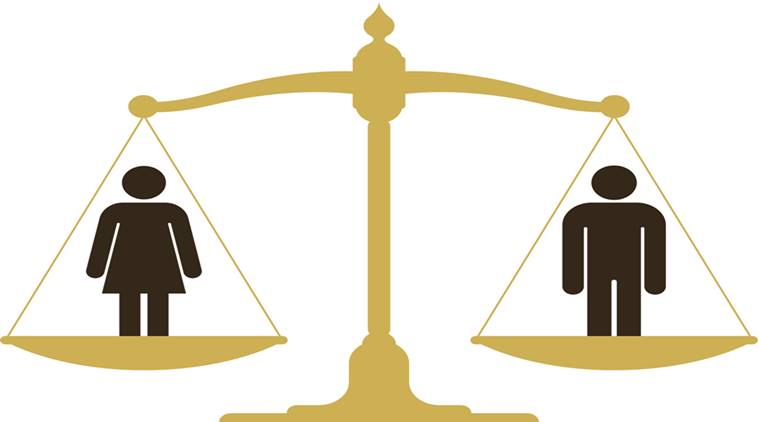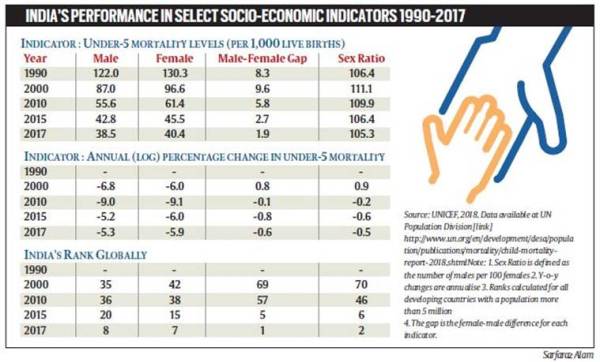Pro-women, pro-poor
India may have just witnessed the best four years of inclusive growth, thanks to the Centre’s sanitation programme

The male/female sex-ratio indicator (how many betihave been saved?), rank for India is number 2.
India’s performance in poverty reduction since the early 1990s has been remarkable. A constant criticism has been that while the decline in consumption poverty has been large, the improvement in social indicators like education and mortality has not been as commendable. Absolute poverty declined from 46 per cent in 1993/94 to only 13 per cent in 2011/12 (Tendulkar poverty line of Rs 30 per capita per month in 2011/12 prices and/or World Bank international poverty line of $1.90 PPP dollars per person per day).
This lack of comparable change in socio-economic indicators has been a consistent phenomenon, and all governments in India have been criticised for this failure. Socio-economic data has shown that improvement in indicators for women was not as good as that for men. Hence, while much had been achieved, gender equality was still lagging in India. One of the signature reforms of Prime Minister Narendra Modi, announced from the ramparts of the Red Fort on August 15, 2014, was the Swachh Bharat Abhiyan. The major component of this programme was to make India OD (open defecation) free by October 2019, the 150th birth anniversary of Mahatma Gandhi, the original proponent of an OD free India. Unfortunately, our reformers forgot his message as they proceeded to make India modern and prosperous but attempted to do so without improvements in sanitation.
The PM boldly stated that open defecation was a major blot on India’s progress, and a major drawback for gender equality in education and safety. Simultaneously, PM Modi announced the Beti Bachao, Beti Padhao (save the daughter, educate the daughter) initiative (aka reform).

These announcements have to be put in perspective of what was expected from PM Modi. Many self-styled economic reformers believed then (and believe today) that PM Modi should have begun to privatise the economy. The fact that he didn’t showed that he was not an economic reformer.
Let us first recognise the boldness of the OD initiative. First, as a surprise to all the upper classes, in India and around the world, a taboo conversation word — defecation — was openly discussed, and by the PM no less. Here we were expecting growth-enhancing reforms, and the PM was talking about defecation. That close to 50 per cent of rural India was indulging in this practice came as a shock to most. This is not what the elite, especially the upper-class elite belonging to the “poverty study” group, had even discussed in private, let alone in public.
Over the last few years, there actually has been a concerted campaign to bad-mouth the toilet campaign. Newspaper stories have emerged about the “fact” that the building of toilets has been exaggerated. For many toilets that have been built, many do not have enough water. I have seen “popular” pictures of farmers’ unused bathrooms being used for storage of grain. Academic analysts warned of a quick-fix; attitudinal change was required, and this was painfully slow. When the first survey results of toilet usage were published (done by the Quality Council of India in 2016), they were criticised for biased sample selection, that is, only high-performing areas were chosen for the survey, and hence could not be relied upon as indicative of what was happening in the backward areas of India (for example, Bihar), states which were not part of the survey.
A few days ago, Finance Minister Arun Jaitley described Swachh Bharat as the most important reform initiative of the Modi government. That is some endorsement, given that Modi’s BJP government has introduced a large set of economic reforms — demonetisation (reduction of black money and enhancement of direct tax revenues); the introduction and implementation of the Insolvency and Bankruptcy Code (IBC), a reform that has not been given the credit due, as yet; and GST. How accurate is Jaitley’s claim that this has been a mega achievement of the Modi government? Most critics (analysts) have dismissed it as usual election year exaggeration. What are the statistics about the decline in open defecation? How can long-entrenched social attitudes change so quickly, especially when “expert” studies have shown that this is a long and arduous journey, which started barely four years ago? Government statistics do not help because they are government statistics, and hence not that credible. As an aside, the samecritics readily accept a badly constructed back-series on GDP data in India. Why? Because this back-series upgraded the GDP growth rates observed in UPA-I and UPA-II. If there is another reason for the ready acceptance of the back-series by the Congress (and its cheer leaders), the nation has yet to learn.
A few days ago, the UN released data for under-five mortality rates for 180 countries for the period 1990 to 2017. Apart from safety and dignity for women, open defecation has major implications for mortality, and especially mortality rates for children. If OD free India has been even partially successful, it should show up in mortality rates for small children (under the age of five). Note that looking at the pace of mortality reduction is not a very stringent test for the success/failure of the OD program.
It is not a stringent test because mortality decline is affected by at least four other important factors — income growth, technological advances (medicine and vaccination), improvement in water supply and education of women. All of these indicators are improving in India, so one cannot attribute the reduction in under-five mortality to the reduction in OD. Possibly, OD is the most important, but how does one prove it?
The table presents data for levels, and the average rate of decline, per year, for India, 1990 to 2017. The largest annual pace of decline for female under-five mortality (as well as for males) was observed during the 10-year period 1990 to 2000. Most socio-economic indicators, unlike income indicators, cannot be analysed in simple rates of change. This is because many socio-economic indicators have floors and ceilings, for example, life-expectancy, education, mortality. The under-five female mortality rate has shown virtually no improvement for Sweden between 2010 and 2017 — a decline from the rate of 2.8 (per 100,000) in 2010 to 2.6 in 2017. This is only a decline of (log) 7.4 per cent, compared to over a 40 per cent decline for India.
Given this caution about floors and ceilings, how does one evaluate India’s performance? The first goal is to compare like with like, that is, compare India to its peers, loosely defined as emerging economies (aka developing countries) with a population greater than five million. Second, to compute ranks of performance with rank equal to 1 for the country with the fastest rate of decline.
Data for India are presented in the table and the reader can, at leisure, interpret the levels and changes. I want to concentrate on India’s rank (among 76 countries) in 2017. India achieves the rank of seven for female under-five mortality, a large improvement over the 15 rank just two years earlier!
Yet another performance indicator is the pace of improvement in female mortality relative to that of males (the difference in the rates of change). For this indicator, India is the best performing country in the emerging world. Finally, the male/female sex-ratio indicator (how many betihave been saved?), rank for India is number 2. This improvement will be assessed in detail in another article.
One must give credit where credit is due. Academics said such a fast rate of change was not possible. Well-known bureaucratic inertia in India meant that even if theoretically (academically) possible, implementation of the OD campaign would face insurmountable hurdles. Add to it the so-called caste factor preventing success.
Why did the programme succeed beyond all calculations? Because it was a pro-poor, pro-female, campaign. Because it improved the safety and dignity of women. Because it was (shockingly!) very well administered. And because it was a high-profile PM campaign.
The writer is contributing editor, The Indian Express and part-time member of the Prime Minister’s Economic Advisory Council.
For all the latest Opinion News, download Indian Express App
More From Surjit S Bhalla
- Not a question of cashWhether demonetisation failed or succeeded is not a moral question. Is it too much to expect that in this data-dependent world, we should discuss hard…
- No Proof Required: GDP Report – misreading the factsBack-series GDP Report mistakenly concludes that GDP growth during UPA-I was higher by 0.5 per cent per annum. GDP growth was very likely lower by…
- Inequality, myth and realityCrony capitalism notwithstanding, there is no evidence that India has experienced an above average increase in income inequality..







































No hay comentarios:
Publicar un comentario